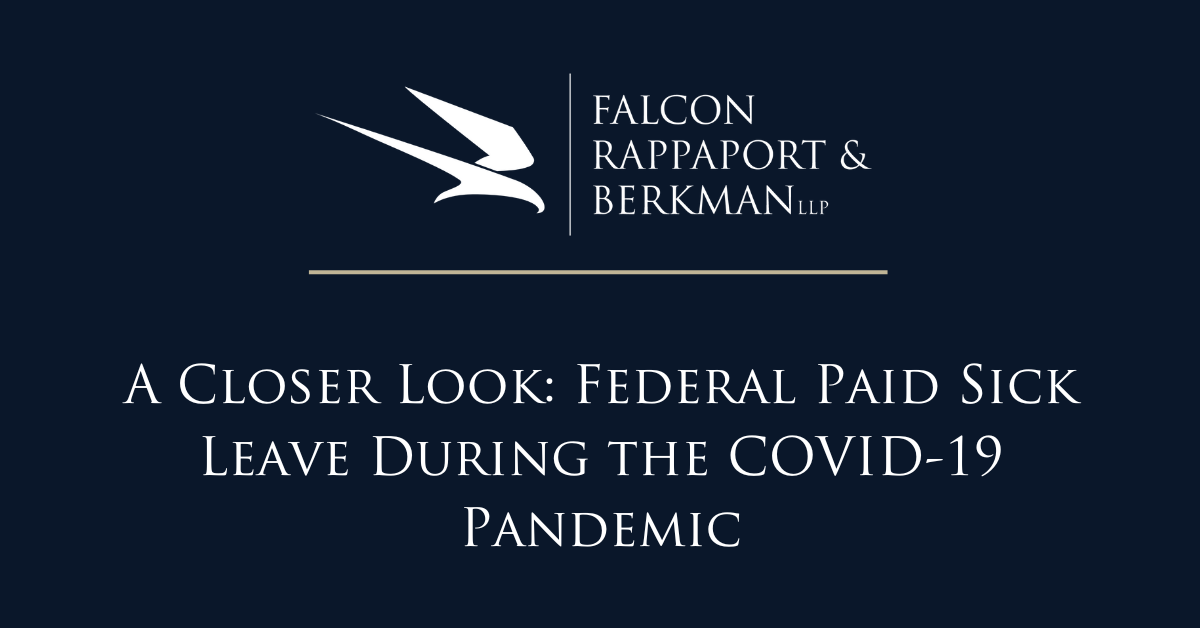A Closer Look: Federal Paid Sick Leave During the Pandemic
A Closer Look: Federal Paid Sick Leave During the Pandemic
The Emergency Paid Sick Leave Act (EPSLA) became effective on April 1, 2020 and expires December 31, 2020 (unless extended). The EPSLA is part of the Families First Coronavirus Response Act (FFCRA). Under EPSLA, covered employers must apprise employees of the law and conspicuously display the new Department of Labor poster. Most federal government employees are not covered under this expansion, but many private employers in New York State will be required to provide paid sick leave under the EPSLA.
Which Employers are Covered?
- EPSLA applies to all private (including not-for-profit) employers with fewer than 500 employees, and certain public agencies.
- Small businesses with fewer than 50 employees may qualify for exemption from the requirement to provide leave due to school closings or childcare unavailability if the leave requirements would jeopardize the viability of the business as a going concern. There is no application process for exemption and is determined by employer based upon certain determinations related to being able to operate the business at minimal capacity.
What is Required of Covered Employers?
- Covered employers must provide up to two weeks/80 hours of paid sick leave to all full-time employees for COVID-19 related purposes (described below).
- Part-time employees are entitled to paid sick leave equal to the number of hours they work over an average two-week period
- Employer must continue payments toward health insurance during leave
Reasons for Taking Paid Sick Leave and Corresponding Entitlements
- Sick leave must be paid at the employee’s required compensation, but is capped at $511 per day and $5,110 per employee, if leave is taken for the following reasons:
- Employee is subject to a federal, state, or local quarantine/isolation order
- Employee has been advised by a health care provider to self-quarantine
- Employee is experiencing symptoms of COVID-19 and is seeking a medical diagnosis
- Sick leave must be paid at 2/3 the employee’s required compensation, and is capped at $200 per day and $2,000 per employee, if leave is taken for the following reasons:
- Employee is caring for an individual subject to a quarantine/isolation order or has received a health care provider’s advice to self-isolate
- Employee is caring for a child whose school has been closed or for whom childcare has become unavailable as a result of COVID-19
- Employee is experiencing any other substantially similar condition specified by the Secretary of Health and Human Services in consultation with the Secretaries of Labor and Treasury
- The applicable rate of pay is the highest applicable wage rate, either the:
- Employee’s regular rate of pay
- FLSA minimum wage, or
- Highest applicable state or municipal minimum wage
How are These Funds Administered?
- Employers will receive 100% reimbursement for federal paid leave through a tax offset against payroll taxes.
- Any amounts in excess will be credited as a refund from the IRS.
EPSLA Limitations
- Employers are prohibited from requiring an employee to exhaust their accrued paid time off (PTO) or state/local paid sick leave.
- Employees may use the federal emergency sick leave before using any state or local leave or accrued employer-offered PTO
Conclusion
Employers and employees across the country will have to factor in their rights and responsibilities under the EPSLA when determining how to best proceed under the circumstances presented by COVID-19.
DISCLAIMER: This summary is not legal advice and does not create any attorney-client relationship. This summary does not provide a definitive legal opinion for any factual situation. Before the firm can provide legal advice or opinion to any person or entity, the specific facts at issue must be reviewed by the firm. Before an attorney-client relationship is formed, the firm must have a signed engagement letter with a client setting forth the Firm’s scope and terms of representation. The information contained herein is based upon the law at the time of publication.

